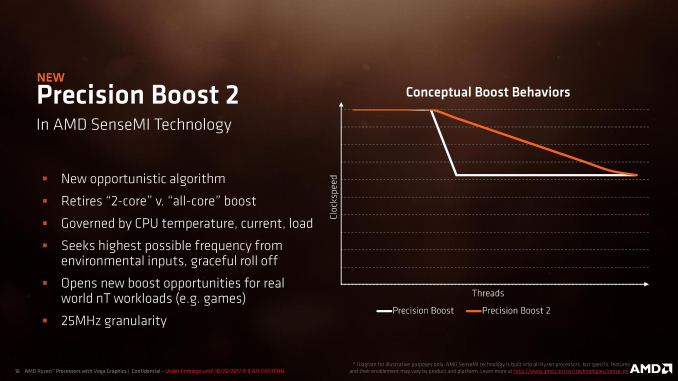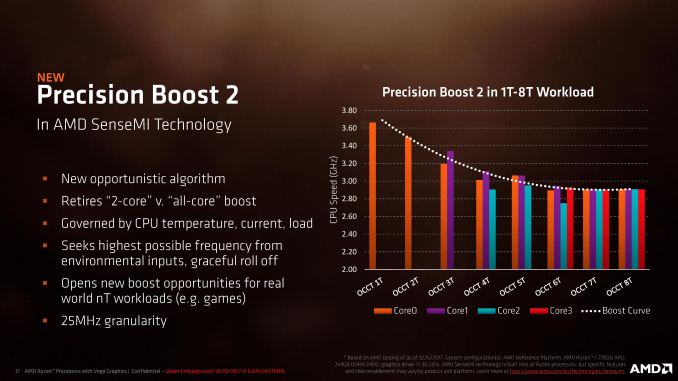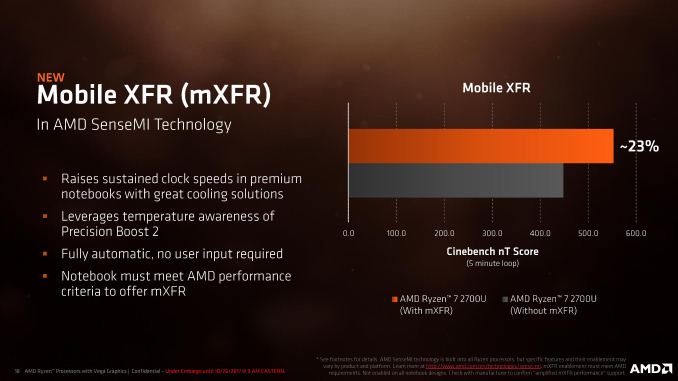Ryzen Mobile is Launched: AMD APUs for Laptops, with Vega and Updated Zen
by Ian Cutress on October 26, 2017 9:00 AM ESTSense Me Ryzen: Better Boost
When AMD launched the desktop Zen processors, it also branded a series of five technologies under the ‘SenseMI’ name. We covered these in detail in our Ryzen 7 review, but in short, it covers the following:
- Pure Power: Sensors to optimize power consumption
- Precision Boost: Determines how Turbo is applied
- Extreme Frequency Range: Going above maximum turbo when possible
- Neural Net Prediction: Using Neural Nets for prefetching data
- Smart Prefetch: Algorithms that work to enhance prefetch
With Ryzen Mobile, the features relating to frequency get an updated model, while Pure Power gets a bigger boost. We’ll cover the power changes on the next page, but it is worth talking about how AMD has improved Precision Boost and brought XFR to laptops.
Precision Boost 2
Most CPU turbo algorithms work by sensing how many cores and threads are under load, determining if the CPU has enough power headroom, and applying a voltage. This is why in the past both of the major x86 CPU manufacturers will quote a ‘per-core turbo frequency’ to show what the frequency should be when different numbers of cores are loaded and all else is fine (there is temperature/power headroom).
For Ryzen Mobile, AMD is pivoting to a new turbo model. When the system is in the P0 (top) turbo state, the system will use a new opportunistic turbo algorithm that rather than being based on the cores under load, is governed by CPU temperatures, currents, and how much load is being applied. The algorithm takes into account all the environmental inputs, such as skin temperature sensors and battery life, and will provide the best turbo frequency it can, regardless of if one thread is being used or all threads are being used.
It will be able to provide boost amounts at the 25 MHz granularity level, similar to how the desktop processors work, with the idea being that in most cases, if the system has a lot of cores available and a background process performs some very light work (such as checking for updates), rather than dropping 500-800 MHz because more cores are loaded, the system will keep at the high frequency.
AMD is stating that this has a big effect on real-world workloads, typically those that have variable thread workloads such as gaming.
When asked if Precision Boost 2 would be coming to the next generation of AMD’s Desktop Ryzen processors, I was told that ‘it could be inferred / it’s a safe bet’.
Mobile Extended Frequency Range (mXFR)
Because mobile systems are thermally limited, battery limited, power limited, and battery limited, offering ‘extra’ turbo headroom is not really something that processor manufacturers like to do. As a result, most of the Ryzen Mobile-powered notebooks will not have any form of XFR – AMD will be allowing it on a case-by-case basis for vendors that overengineer their chassis to be capable of supporting a higher power profile.
This feature essentially extends the average level at which Precision Boost 2 will operate, and also marks what could be considered a higher configurable TDP. One of the systems being launched with Ryzen Mobile this side of Christmas will be mXFR enabled, because the chassis is designed for 25W rather than 15W. It is worth noting that AMD states the configurable TDP of the Ryzen Mobile chips goes up to 25W, so this is likely the case what is happening.
Encode and Decode
AMD is fully using Vega’s encode and decode capabilities with Ryzen Mobile. The big inclusion for AMD’s mobile devices is the ability to decode VP9, the codec prefered in particular by YouTube.
| AMD Ryzen Mobile Encode/Decode Capabilities | |||||
| Decode 1080p @ 4:2:0 |
Decode 2160p @ 4:2:0 |
Encode 1080p |
Encode 1440p |
Encode 2160p |
|
| MPEG2 | 60 FPS | - | |||
| VC1 | 60 FPS | - | |||
| VP9 8/10 bpc | 240 FPS | 60 FPS | |||
| H.264 8 bpc | 240 FPS | 60 FPS | 120 FPS | 60 FPS | 30 FPS |
| H.264 10 bpc | 240 FPS | 60 FPS | |||
| HEVC 8bpc | 240 FPS | 60 FPS | 120 FPS | 60 FPS | 30 FPS |
| HEVC 10 bpc | 240 FPS | 60 FPS | |||
| JPEC 8bpc | 240 FPS | 60 FPS | |||













140 Comments
View All Comments
serendip - Friday, October 27, 2017 - link
Indeed. I've got 3 windows of Firefox running with a total of 50 tabs plus LibreOffice - all on an Atom tablet with 4 GB RAM. Typical office workflows don't need more than 4 GB especially as Windows 10 is quite memory-efficient. I've even run Ubuntu desktop VMs on this tablet with no hiccups.extide - Friday, October 27, 2017 - link
If you're using 7GB then you should have 16GB in there otherwise you will have no room for disk cache. You really don't want your actual apps to be using all of your physical memory..mdriftmeyer - Friday, October 27, 2017 - link
5 to 7 GB in Brower on top of several GBs for the OS. Do the math.Icehawk - Friday, October 27, 2017 - link
Would love to see a SS showing 5gb of explorer windows, good luck with that.extide - Friday, October 27, 2017 - link
ECC isn't really effective against rowhammer as it induces multi-bit errors. Really, rowhammer isnt much of an issue in the real world.Krysto - Thursday, October 26, 2017 - link
I'm hoping AMD adopts the new codec (AV1 or NETVC, whichever it is), ASAP, if it's finalized by the end of the year. I guess it will be too late to go into Zen 2 for next spring, but it should be supported in Zen 3 at least.MajGenRelativity - Thursday, October 26, 2017 - link
It takes time for CPUs to be developed, so it probably depends on how far the codec is along, and how closely AMD is involved.extide - Friday, October 27, 2017 - link
The codecs will track the GPU's so based on that timetable it is unlikely to get into Navi, so whatever comes after Navi and then whatever APU uses that post-Navi GPU.mdriftmeyer - Friday, November 3, 2017 - link
They'll never adopt a VP9 based codec in hardware. Why? Google has abandoned it and isn't developing it further. They're transferring it to Cisco.However, Google decided to incorporate VP10 into AOMedia Video 1 (AV1). The AV1 codec will use elements of VP10 as well as the experimental formats Daala (Xiph/Mozilla) and Thor (Cisco).[94][95][96] Accordingly, Google has stated that they will not deploy VP10 internally or officially release it, making VP9 the last of the VPx-based codecs to be released by Google.
NETVC will also never be added to hardware. Unless you think AMD or Nvidia will bank on anything outside of the MPEG LA you're dreaming.
peevee - Thursday, October 26, 2017 - link
Sounds very very sweet. Especially if laptops with all that power can be made with passive cooling (15W should be fine in a proper metal design).